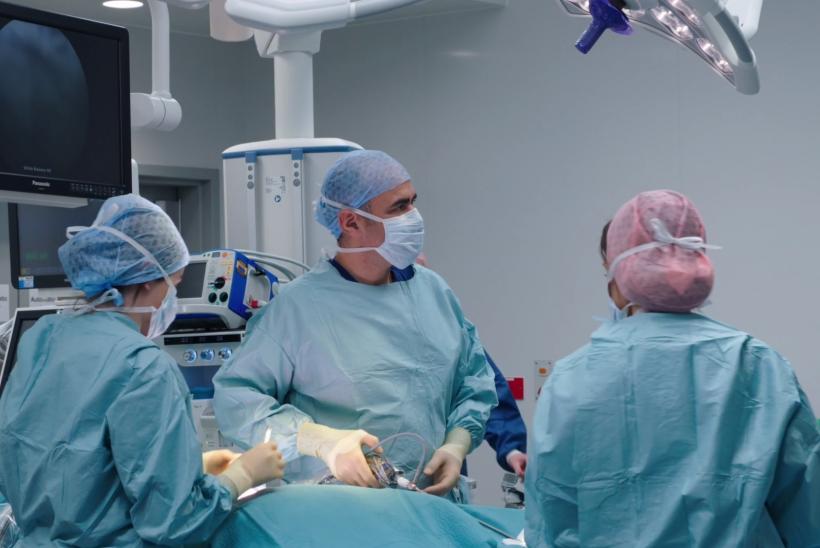A Meeting of Minds
When the brightest minds from across the world come together, amazing things can happen. Take the latest breakthrough to come from a pioneering international study, led by the UCL Great Ormond Street Institute of Child Health (UCL GOS ICH), funded by GOSH Charity and Oak Foundation, supported by Italy’s University of Padova, colleagues from Veneto Institute of Molecular Medicine and the Shanghai Institute for Advanced Immunochemical Studies, Shanghai Tech University, China.
The international group developed a ground-breaking 3D bioprinting technique that could replace missing or damaged tissue without the need for open surgery. They created a photosensitive bio-gel that uses UV light to ‘print’ healthy new tissue directly into specific tissues and organs. Tested in the UK and Europe, the light-sensitive bio-gel acted as a type of bio-ink, in the muscle of live mice, effectively ‘printing’ 3D structures that supported the creation of muscle fibres.
“We wanted to develop a technology we could control with micro- and keyhole surgery,” Consultant General Neonatal and Paediatric Surgeon at Great Ormond Street Hospital (GOSH), Prof. Paolo De Coppi, who is co-author of the study, explains. Paolo is also a National Institute for Health Research Professor and Nuffield Professor of Surgery at the UCL GOS ICH. “The new technique means not only are we able to control centimetre or millimetre printing, but will be able to print even smaller than that.”
So what does this new research, which was also conducted in partnership with GOSH, mean for patients?
It could pave the way for organ repair and reconstruction with minimally invasive surgical techniques, subsequently removing the need for transplantation in children with complex conditions.
“This could change the way we treat congenital malformations such as spina bifida and diaphragmatic hernia at GOSH,” Paolo adds. “We still have plenty of work to do before we can safely use this approach with patients, but the findings are promising.”
Life-changing research Initially tested on the skin and brain of the mouse, the team’s technique – coined Intravital 3D Printing, or i3D Bioprinting – was also successfully carried out in the muscle of a mouse where it created new tissue without causing damage to surrounding organs or tissues.
Furthermore, it didn’t create any waste material inside the body and has the potential to carry healthy donor cells. This could be life-changing in cases where a child’s own cells aren’t suitable or available to help repair or reconstruct damaged or missing tissue.
Project lead Professor Nicola Elvassore, whose research team spans across the ICH and centres in Italy and China, says: “We’re really excited our technique seems to be much more controllable in three dimensions, allowing us to accurately image, in 3D, the anatomical sites of interest, then safely print new tissue in areas not easy to access without major surgery, like the brain.
First-author of the study, Dr Anna Urciuolo, visiting research associate at ICH and Junior Principle Investigator (the person responsible for preparation, conduct and administration of a research grant), in Italy, adds: “It’s an exciting, challenging project, requiring the fusing of emerging technologies in a multi-disciplinary way. By performing 3D bioprinting directly within the body of a live animal model, we could deliver donor muscle stem cells in a spatially controlled manner, increasing their ability to develop new muscle tissue.”
Although still in its pre-clinical stage, this kind of tissue engineering research could lead to a new standard of care for patients with complex physical conditions, especially in the case of children with damaged organs. And it’s this type of international collaboration – and charity funding – that is crucial for research programmes, Paolo adds. “International collaboration is essential for large-scale projects that will, ultimately, benefit children globally, because we can all work closely together,” he says.
Bench-to-bedside – research in action De Coppi and his team at GOSH are based at the Zayed Centre for Research into Rare Disease in Children, a ground-breaking facility created from a partnership between GOSH, UCL, GOSH Charity, and a transformative gift of £60 million pledged by Her Highness Sheikha Fatima bint Mubarak, the wife of the late Sheikh Zayed bin Sultan Al Nahyan, Founding Father of the United Arab Emirates. Opened in October 2019, it was created to house numerous clinicians and researchers and bring patients under the same roof, helping to fast-track new treatments and cures to those who need them most. “It’s a fantastic centre and we feel very privileged to be there,” Paolo adds.

